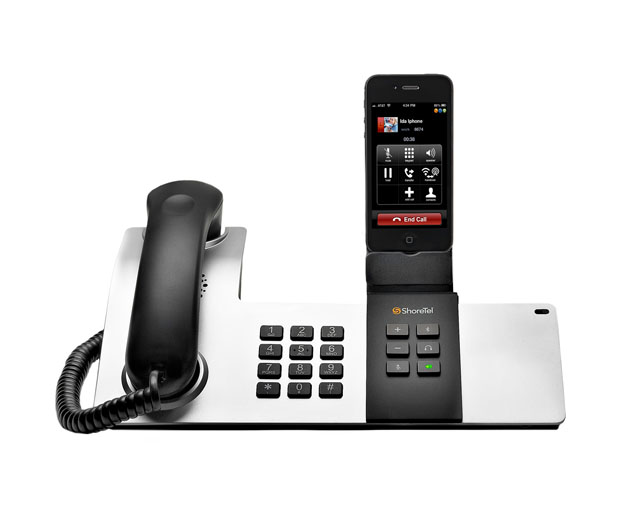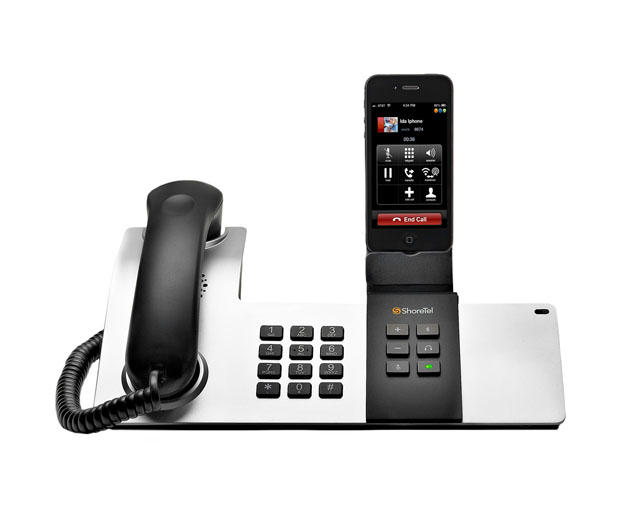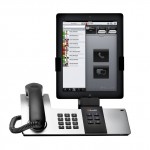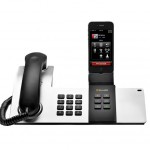
blog We couldn’t help but goggle when we received a media release yesterday from enterprise telephony vendor ShoreTel pushing what the company dubs “the first enterprise-grade docking station for Apple iPad and iPhone”. The devices — to be available in Australia in the third quarter of this year — allow users to integrate their iPhones and iPads with ShoreTel’s corporate telephone platform. In the words of the company itself:
“The ShoreTel Dock transforms Apple® handhelds that are running the ShoreTel Mobility app, into powerful business desk phones and enterprise collaboration tools. Employees can simply slide their ShoreTel Mobility enabled iPhone or iPad into the ShoreTel Dock and get instant access to the comfort, battery life and call quality of a business desk phone. The ShoreTel Dock only requires a single power adaptor and automatically keeps Apple handheld devices charged so employees have a full battery. When combined with ShoreTel Mobility and conferencing applications, users get a phenomenal UC experience, utilising voice, instant messaging (IM), presence and conferencing on a device that they already know and love.
The ShoreTel Dock hardware and ShoreTel Mobility software work together, making life easier for the user. Users can place and answer calls by simply picking up the handset and dialing a number on the dial pad or on the device’s screen; the ShoreTel Dock automatically launches the ShoreTel Mobility application so the user doesn’t have to think to do so. The simple and clean design of the handset, dial pad, speaker phone and audio controls allow users to enjoy the familiar comfort of a desk phone when using their iPad or iPhone at their desks, making BYOD an even better experience.”
We can sort of understand the iPhone dock, as it is indeed useful for those working in large organisations to be able to integrate their iPhone with their corporate phone. We know of many people who merely have their work number forwarded to their mobile, but this obviously doesn’t bring the full benefits of integration with the corporate directory, the ability to place internal calls over Wi-Fi and so on. A dock integrating the iPhone with a corporate telephone makes a degree of sense in this context, and we can see people actually using ShoreTel’s device in this capacity, although it does look a little odd.
However, the iPad dock is another scenario entirely. To be honest, ShoreTel’s solution looks very unwieldy here — it looks as though the iPad’s hardware connector could be broken relatively easily merely by nudging it with your elbow; the whole setup looks unbalanced, with the iPad itself larger than ShoreTel’s dock. Perhaps an iPad mini would be better. In addition, we’d question the benefit of corporate telephony integration here … even if you accept that users are conducting tasks such as videoconferencing from their desks, wouldn’t they do this on their PC or laptop as a preference, or even from the iPad itself through ShoreTel’s app? We’re not sure there’s really a need or a desire to connect such a large tablet to a corporate dock.
Anyway, let us know your thoughts below — we’re extremely curious to know whether this is the sort of thing people would deploy in their offices.
Image credit: ShoreTel




I do wonder how they would make this work with the variety of Apple devices. I know that my iPad 4 has a lightning plug instead of the old 30pin plug.
I also believe even the current gen iPhone has the 30pin plug, which makes me think maybe they have a converter or the dock feature is interchangeable.
Still, i don’t see why people would bother using something like this for an iPad, it seems kinda bulky and almost like the iPad would have trouble staying up after a few uses.
“I also believe even the current gen iPhone has the 30pin plug, which makes me think maybe they have a converter or the dock feature is interchangeable.”
The only iPhone still being sold with 30 pin connector is last year’s iPhone 4S. The iPhone 5 has lightening. Pretty easily solved with an adapter in the meantime (although they are a bit large and ugly) or by waiting for the lightning compatible dock Shoretel have coming up.
I actually quit like the product. Although I agree the iPad looks a bit awkward and unstable in the pictures, but from what Jamie was saying above, it sounds like it is quite stable, and I like that its adjustable to different angles.
I would be very surprised if this was a lightning dock. Looks like iphone 4/4s/ipad 3 only. That may be a problem going forward….
Renai – it’s a shame that you weren’t able to attend the product launch yesterday. We had an advance unit at the event and we demonstrated how it worked in conjunction with ShoreTel’s Mobility client. I think that would have answered some of the questions you posed in the article. Using ShoreTel’s Mobility client together with the Dock provides full UC functionality through the mobile device making it an extremely powerful combination and gives the user connectivity into the corporate directory, presence, IM and collaboration functions. The Dock combined with ShoreTel Mobility is also PBX vendor agnostic, not tying it to use with ShoreTel’s PBX alone.
You also need to think about scenarios where the Dock will have a role to play – it’s not necessarily replacing the desk phone, but addresses the mobile worker, users who are working from home, contracting or hotdesking.
It’s true that the first model of the Dock that we are releasing is for Apple devices using the 30-pin connector, with a Lightning connector version due before the end of the year. However, the ShoreTel Dock will work with a Lightning to 30-pin adaptor available from Apple or one of their resellers. The great thing is the user will experience no degraded functionality. The main reason for this is that we are addressing the massive install base out there today for iPads and iPhones that predate the newer generation devices using the Lightning connector.
In terms of the ergonomics of the Dock with the iPad, it’s hard for one or two pictures of the device to do it justice – the Dock has a cradle for the iPad to ensure that it is held securely in place, and it also allows the user to easily swivel it from portrait to landscape; the design offers very little risk of the support arm breaking. If you watch the video, you will see what I mean: http://www.shoretel.com/resource_center/videos/ShoreTel_Dock_Intro_Video.html.
Please tell me you’re making an Android version.
Z of Perth – While the primary target devices for this model of the ShoreTel Dock are the iPad and
iPhone, users may also connect, by Bluetooth, other smartphones/tablets including Android
and BlackBerry, since we have implemented a standards-based Bluetooth Hands-Free
Profile(HFP).
The iOS platform was selected for the first model due to the significant leadership it
has in the tablet space with the iPad having 43.6% market share. We continue to evaluate
the opportunities for Android smartphones and tablets.
Been done before by other vendors with other PDAs/phones. Looks sexy but is pretty useless in a true business environment
Michael – I agree. Several manufacturers have developed this kind of integration before and sold nearly zero product (e.g., more than ten years ago Mitel introduced the Mitel 5230 IP Phone with built-in PDA docking station and while it had a little splash at trade shows, you didn’t find them at many customer sites).
There are two main problems I see with this type of product. First, in today’s wireless world why would you even need to “dock” an iPad or iPhone in order to get complete integration. If you take something like Mitel’s Unified Communicator Advanced software running on the iPad, iPhone, or Android, users have corporate directory with presence, SIP soft phone, call hand-off between devices, and chat, all through either Wi-Fi or the mobile phone data network.
Secondly, the mobile device market evolves very rapidly. I see already see discussion in this thread about 30-pin versus Lightning connector, what kind of connector will be on the next model? Today Apple has a very large market-share with both iPad and iPhone. But the iPhone is 6 years old and the iPad only 3. As recent as four years ago RIM devices were outselling both Apple iOS and Google Android. Google quickly jumped into the lead three years ago and has held that lead, but in today’s ever changing market, what will happen next year? Could some new product be introduced making both Android and Apple devices obsolete? If so, what does the user with a product-specific piece of hardware on their desk do?
Glorified Charger.
Awesome! Thank you for this wonderful article; it makes my marketing skills more productive, this article can help a lot of business affiliates like me to enhance their perception and knowledge <a href=" http://goo.gl/1wo5h
There’s obviously something I’m not understand here. You plug your (i)Phone into your (desk) phone so that you can use your (desk) phone as a phone? Why not just pick up your desk phone and you know, call the person you want to call?
Comments are closed.